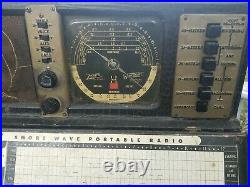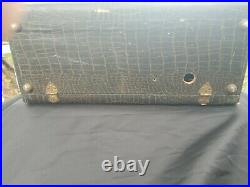












Zenith Model 7G605 “Clipper” TransOceanic Radio(1942). Radio plays fine gets Shortwave on 25meter band. I have no service record on radio but plays loud and clear. Radio looks to have had handle replaced. This is Zeniths first run with sail boat only 10,000 or so made. Here you see the legendary “Clipper, ” the original TransOceanic portable that launched a radio dynasty lasting 40 years. The Zenith TransOceanic was the brainchild of Commander Eugene F. McDonald, the head of Zenith and a dedicated traveler and yachtsman. Frustrated that ordinary Zenith sets didn’t perform well in remote areas, he ordered his engineers to develop a new portable that could receive shortwave broadcasts anywhere in the world. War Baby Model 7G605’s history is intimately connected with World War II. It began manufacturing around October, 1941 and went on sale to the public in January, 1942. That was just in time to supply a few lucky World War II soldiers with a rugged portable that they and their buddies could use anywhere in the world. TransOceanic ads from these years feature testimonials from grateful owners, describing how their faithful sets survived dunking, falling from jeeps, extreme climactic conditions and other misadventures in faraway lands, all the the while providing welcome news and entertainment from home. The last Clipper was built in April, 1942, when the US government shut down all domestic radio manufacturing to provide for military needs. My Clipper bears serial number T849721, indicating it was made in the first production run of 10,000 units. Zenith took advantage of the wartime experience to cloak the TransOceanic with an aura of glamor that remains to this day. The legend is firmly grounded in reality, however. For its time, the original TransOceanic was indeed a high-performance set, built to high standards. And Zenith maintained those standards for the TransOceanic line over a period of decades. Description Like its cheaper “companion” set, the 6G601M Universal, the Clipper has a cabinet that’s basically a little suitcase, with detachable front cover and hinged back. The front cover looks a little off-kilter here, but that’s because I wasn’t quite on-center when I took the photo. Most Clippers feature the bomber grille pattern shown here. A few sets in the first production run used the same sailboat design as the 6G601M, but the sailboat was soon replaced by the bomber by order of the patriotic Commander McDonald. For a 1940s appliance, this set is quite user-friendly, with simple controls and integrated instructional material. To the far right are the six bandswitches, each marked to indicate the best time of day for reception on its band. Further operating instructions appear on a card permanently mounted inside the front cover. The round power/volume and tuning knobs feature a distinctive “lightning Z” Zenith logo. Above them is the Radiorgan, a group of four tone switches marked Treble, Voice, Alto, and Bass. The dramatic gold and black tuning dial features a delicate pointer that repeats the lightning Z emblem. Zenith made much of the TransOceanic’s distinctive antennas. The large telescopic antenna was dubbed the Waverod. It can be rotated upright, then extended vertically. The second antenna is called the WaveMagnet, a moniker that Zenith applied to many antennas over the years. It is a big loop antenna at the end of a flexible straplike cable that you can plug into the back of the radio. The body of the antenna has rubber suction cups. When not in use, it stows away with clips inside the back cover. Both antennas can be seen in the next photo. With its cable and suction cups, the WaveMagnet could be attached to the window of a train, airplane, or boat. Ordinary radios might be silenced inside those metal vehicles, but you could improve your reception by sticking your WaveMagnet onto the window next to you. The rubber suction cups on WaveMagnet antennas always become dried and stiff with age. I have been told that you can revive their pliability by soaking the suction cups in a solution of WD-40 for several daysa procedure that I haven’t yet tried. This radio employs “loktal” type tubes which snap securely into their sockets. The six tubes are: 117ZG6, 3Q5, 1LN5, 1LA6, 1LN5, 1LD5. The Clipper can use either line current (110-volt AC or DC) or DC power from a large battery pack. Headphones were available as an option. They plugged into a two-pronged jack in the back of the chassis. Before starting any electronic restoration, you should get a schematic to guide your work and help you understand the electronics. You can download the 7G605 service manual from Nostalgia Air or order it from one of the sources listed in our Parts page. The TransOceanic Legacy While researching other Zenith patents, I ran across No. 2,378,663, a remarkable document that includes many details of the TransOceanic Clipper. This patent drew upon others held by Commander McDonald himself. Numbers 2,237,260 and 2,250,387 present the general idea of a portable radio with detachable antenna that can be stuck onto a window. In this document, however, you see the entire radio, from outward appearance to construction details and even the schematic diagram. As you can see from the diagrams, this is unmistakeably the Clipper, not some generic box representing any portable radio. The full patent runs to 17 pages and makes interesting reading if you don’t mind wading through dense legalese. Although Zenith made various improvements over the next four decades, this patent created the framework for all subsequent TransOceanicssurely one of the longest-lasting designs in radio history. The other articles in this section chronicle how the TransOceanic evolved from this early form to its final incarnation, the all-transistor R-7000. As an historical footnote, despite this highly detailed patent, several other companies, including RCA, Hallicrafters, and Stromberg-Carlson, produced portable multi-band radios that were clearly knockoffs of the TransOceanic. I don’t know whether Zenith ever troubled to sue them for patent infringement. The item “Zenith 7G605 Trans Oceanic radio, sail boat version, tested” is in sale since Monday, October 4, 2021. This item is in the category “Collectibles\Radio, Phonograph, TV, Phone\Radios\Tube Radios\1930-49″. The seller is “fprince555″ and is located in Racine, Wisconsin. This item can be shipped to United States, Canada, United Kingdom, Denmark, Romania, Slovakia, Bulgaria, Czech republic, Finland, Hungary, Latvia, Lithuania, Malta, Estonia, Australia, Greece, Portugal, Cyprus, Slovenia, Japan, China, Sweden, South Korea, Indonesia, Taiwan, South africa, Thailand, Belgium, France, Hong Kong, Ireland, Netherlands, Poland, Spain, Italy, Germany, Austria, Bahamas, Israel, Mexico, New Zealand, Singapore, Switzerland, Norway, Saudi arabia, United arab emirates, Qatar, Kuwait, Bahrain, Croatia, Brazil, Chile, Colombia, Costa rica, Panama, Trinidad and tobago, Guatemala, Honduras, Jamaica, Antigua and barbuda, Aruba, Belize, Dominica, Grenada, Saint kitts and nevis, Saint lucia, Montserrat, Turks and caicos islands, Barbados, Bangladesh, Bermuda, Brunei darussalam, Bolivia, Ecuador, Egypt, French guiana, Guernsey, Gibraltar, Guadeloupe, Iceland, Jersey, Jordan, Cambodia, Cayman islands, Liechtenstein, Sri lanka, Luxembourg, Monaco, Macao, Martinique, Maldives, Nicaragua, Oman, Peru, Pakistan, Paraguay, Reunion, Viet nam, Uruguay.
- Brand: Zenith
- Time Period Manufactured: 1930-49

